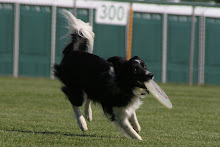I started writing about training a boundary cue Here and Here. After the second post, I kind of gave up on it. Jun wasn't getting it and I was out of ideas. Awhile after giving up on it I had an epiphany and realized that I already had a boundary cue on all of my dogs. They all stay in a car or crate with the door open until told to exit. They all auto-stop at the gate to the front yard and don't cross the threshold until told (mostly). And I tested it and found that they will all wait in a doorway if told to do so with the command "stay here" (And yes, I can use "stay" in this context because I don't use a stay command for a formal stay. My dogs just hold a position until released.)
So how did I train this boundary cue? When the dog tries to leave the area I'd like them to stay in, I calmly body block them (or block them with the door) until they stop trying to leave. Then I mark (yes) and reward them with a release. I think the reason I didn't think of this as a boundary cue was because I had never worked it for duration. I had previously used it mostly as a pause at a threshold, but usually released the dog fairly quickly. But I decided to try working duration with it and I got the exact result I was trying to achieve with the work I wrote about in the other two posts. The dogs will usually stand there for a bit, then lie down and stare at me for awhile, but when they realize they're not going to get released right away they decide to go and do other things. Either behavior, I am fine with! If they come back to the boundary and forget they're not supposed to cross it, I just remind them by body blocking. No treats are needed, since their reward is the release to cross the boundary!
Sometimes dog training is simple!!
P.S. Speaking of epiphanies, I realized the other day that Jun doesn't have a default "sit." You know--the one thing EVERY pet dog knows--sit when you want something. I'm not sure how this particular training bit got overlooked (or maybe I just let it lapse at some point), but it suddenly explained why she is always jumping up to try to grab things out of my hands (which I'd been trying--fairly unsuccessfully--to correct by ignoring, but ignoring doesn't do much if the dog doesn't have an alternate behavior to offer). So Jun--my highly trained sport dog--is now learning something that every pet dog in the world knows.
Subscribe to:
Post Comments (Atom)





I guess I don't really understand what you're doing differently now that you weren't before. Is it the reward with the release part?
ReplyDeleteThe car, crate, and gate are certainly where I use my boundary cue as well as doorways (to the outside and from room to room). If it's the not the treating part you did differently, is it just that Jun was finally able to generalize that word now from the other practices?
Well, before I think I wasn't doing as much body blocking and was more trying to SHAPE it, and tossing treats as the reward for stopping at the threshold or being anywhere behind the threshold, then trying to build duration gradually. Whereas when I teach a wait, I just use body blocks and IME the dogs figure out pretty quick that waiting works and pushing forwards doesn't.
ReplyDeleteBut my main point was, I was trying to teach this as a whole new behavior when I really already had the behavior I wanted, and it was not nearly as difficult as I was making it. The part behavior I was going for when I started initially was the dog staying in a room but being able to move freely about the room. I had the pause part, and as it turns out, I had the rest of it too. Does that make more sense?